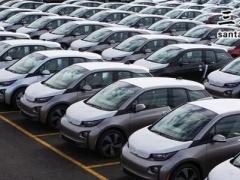中国严重的水资源短缺危及经济前景 [俄罗斯媒体]
深受中国评论人士和经济学家们钟爱的动物寓言——黑天鹅、灰犀牛、白象以及意指反腐战争的“老虎和苍蝇”,现在需要增加一位新成员了——欢迎来到“骆驼”经济,它必须迅速适应水资源缺乏。一场危机迫在眉睫——其经济、社会及政治影响可能比人口特征(指老龄化)、债务和去杠杆化严重得多。
China’s acute water shortage imperils economic future
中国严重的水资源短缺危及经济前景
The bestiary beloved of China commentators and economists needs an addition to its black swans, grey rhinos, white elephants and the ‘tigers and flies’ targeted in the corruption war. Welcome to the Camel Economy, one that must adjust very rapidly to water scarcity. A crisis looms, with potentially far more serious economic, social and political consequences than demographics, debt and deleveraging.
深受中国评论人士和经济学家们钟爱的动物寓言——黑天鹅、灰犀牛、白象以及意指反腐战争的“老虎和苍蝇”,现在需要增加一位新成员了——欢迎来到“骆驼”经济,它必须迅速适应水资源缺乏。一场危机迫在眉睫——其经济、社会及政治影响可能比人口特征(指老龄化)、债务和去杠杆化严重得多。
So why is water scarcity not a central feature of studies of China’s economic outlook? Why is it not recognised as a constraint on economic growth and thereby China’s power? After all, in 2005 the Minister of Water Resources declared a need “to fight for every drop of water or die, that is the challenge facing China”, while former premier Wen Jiabao said that water shortages threatened “the very survival of the Chinese nation”.
既然如此,为何缺水不是中国经济前景研究的一个中心要素呢?为什么它不被认为是对中国经济增长乃至实力增长的制约呢。要知道,2005年,水资源部长曾宣称需要“要么为每一滴水而战,要么灭亡,这是中国面临的挑战”,而中国前总理温家宝则表示,水资源短缺威胁着“中华民族的生死存亡”。
Is it really that bad? Unfortunately, it is. Accepted definitions of water stress, scarcity and acute scarcity are resources of 1,700 cubic meters, 1,000 cubic meters and 500 cubic meters per person per year, covering everything from nuclear power stations to teeth cleaning. China’s overall resources are roughly 2,000 cubic meters, but 80 per cent of water resources are in the south. In the north, eight provinces suffer from acute water scarcity, a further four from scarcity. They account for 38 per cent of China’ agriculture, 50 per cent of its power generation, 46 per cent of its industry and 41 per cent of its population.
真的有那么糟糕吗?不幸的是,是这样的。根据公认的标准,水资源紧张、短缺和严重短缺的标准分别为人均1700、1000和500立方米,涵盖一切用水——从核电站到刷牙。中国总体人均水资源约2000立方米,但80%的水资源集中在南方。在北方,有8个省份遭受严重缺水,还有4个省份缺水。共占中国农业的38%,发电量的50%,工业的46%以及41%的人口。
Here are a few more scary statistics for economists to consider. The water resources of the 112m population of the Beijing/Tianjin/Hebei region, equate to half of acute scarcity. In the past 25 years, 28,000 rivers have disappeared. Groundwater has fallen by up to 1-3 metres a year. One consequence: parts of Beijing are subsiding by 11cm a year. The flow of the Yellow River, water supply to millions, is a tenth of what it was in the 1940s; it often fails to reach the sea. Pollution further curtails supply: in 2017 8.8 per cent of water was unfit even for agricultural or industrial use.
经济学家需要考虑下面这些更可怕的数据。北京/天津/河北地区1.12亿人口的水资源,相当于严重短缺水平的一半(即250立方米每人)。在过去25年间,有28000条河流消失了。地下水水位每年降低最多1~3米。其中一个后果是:北京部分地区地表每年下沉11厘米。供应以百万计人口的黄河的流量,是20世纪40年代的十分之一——它经常无法到达大海。污染进一步削减了供应:2017年,8.8%的水甚至不适合农业或工业用途。
The consequences of scarcity are all too human. In Lintao city residents in high rise buildings must carry water up to their apartments. In Taiyuan, capital of Shanxi province (population 35m), the 2,500-year-old famed vinegar industry is under threat, while at the main international hotel last year guests were advised that water for washing was available for one hour a day. Zhengzhou’s projected population increase of 3m-4m by 2020 may be unrealisable: there is water for only one of seven new purifying plants.
水资源短缺的后果对人影响极大。在临洮,高层建筑居民必须把水搬运到公寓。在山西省会太原(人口3500万),拥有2500年历史的着名酿醋业正面临威胁,同时在去年,各大国际酒店的客人被告知每日的洗浴用水只供应一个小时。到2020年,郑州市预计人口将增加300万至400万——这可能无法实现:水资源只能满足7个新水净化厂中1个的需求。
The political challenge is immense: China’s Five Year Plan implies halving per capita water consumption while doubling China’s 2010 GDP.
政治挑战是巨大的:中国的五年计划要求人均用水量减半的同时,GDP在2010年基础上翻一番。
“Don’t worry,’ say economists, “China has the South North Water Transfer Project (SNWTP). They can shift water. Or desalinate it.” Alas, not in sufficient quantities. Even if all the water of the SNWTP went to the Beijing/Tianjin/Hebei region, it would still leave its population suffering acute water scarcity. But it must also supply three other provinces. Transfers from Tibet or Russia are fantasy. Desalination is dotty: it is very power-consuming and power generation (still largely coal) consumes much water.
“别担心,”经济学家说,“中国有工程。他们可以调水,或淡化海水。唉,可惜量不足。即使南水北调所有水都流入北京/天津/河北地区,该地区人口依然会面临严重缺水的困扰。但它还必须供应其他三个省份。从西藏或俄罗斯调水是幻想。海水淡化是不可靠的:耗电量巨大,而发电(主要是燃煤)会消耗大量的水。
The Chinese government is moving too slowly towards the Camel Economy. It has plans, incentives for officials; it invests in recycling, irrigation, pollution, drought resistant crops; it leads the world in high voltage transmission (to get hydro, wind and solar energy from the west of China). None of this is sufficient or likely to be in time. The most effective measures are the most difficult politically: raising the price of water from around a quarter of the world’s average, ensuring better governance (too many ministries are involved in decisions, vested interests interfere), abandoning a policy of self-sufficiency in food, moving away from power consuming industries (steel and aluminium). It is easier to kick the watering can down the road.
中国政府朝“骆驼”经济转变的速度太慢了。它有激励官员的发展计划;它投资资源回收、灌溉、污染、耐旱作物;它在高压输电领域领先世界(从中国西部获得水电、风电和太阳能)。这些都不够充分,也似乎不够及时。最有效的措施在政治上也是最困难的:提高水价——现有水价大约是世界平均水平的四分之一,确保更好的治理(太多部门参与决策,既得利益者干预),放弃粮食自给自足政策,远离耗电产业(钢和铝)。更简单的办法是扔掉那些浇水壶。
Yet a Camel Economy is what China has said it wants: high tech manufacturing, service based, rebalanced towards consumption (current water pricing/subsidies favour industry over consumers), an efficient agriculture sector (highly important, since agriculture currently uses 62 per cent of water resources).
然而中国已经表达了它想要“骆驼”经济:以高科技制造业、服务业为基础,调整转向消费驱动(当前水定价/相比消费者,补贴更倾向于工业),一个高效的农业部门(农业非常重要,因为当下农业使用了水资源的62%)。
There are global implications: price increases for agricultural products; investment or co-operation with companies that develop water saving technology; wider science and technology co-operation; relocation of water consuming industries outside China. Less positively, failure to achieve a Camel Economy would greatly affect world trade, investment and employment; in the worst case, legal and illegal migration levels could rise, as would tensions over transboundary water.
还有一些全球影响:农产品价格上涨;投资节水技术公司或与之合作;更广泛的科技协作;耗水行业转移至中国之外。不太乐观地说,若无法实现“骆驼”经济,将极大地影响世界贸易、投资和就业;最坏的情况是,合法和非法移民数量可能上升,跨国界水资源紧张局势也会加剧。
Perhaps the biggest implication is for China’s global ambitions, which require a powerful and sustainable economy. Economists might want to ask themselves whether water scarcity will put paid to those ambitions. You can print money, but you can’t print water.
或许受影响最大的是中国的全球抱负——这需要一个强大而可持续的经济。经济学家也许想要问自己,水资源短缺是否会终结这些雄心壮志。你可以印钞票,但不能印水。
Old School Canuck
Excellent commentary about a problem that has long loomed yet is only infrequently discussed outside China (as others here have observed).
这是一篇优秀的评论员文章,讨论了一个长期存在的,但在中国以外的地方很少讨论的问题。
Lu Xun
Great to see an FT article about China that clearly understands the problems. Most foreigners see China seamlessly rising completely problem free in the 21st Century. That's because Western press either don't know what they don't know and / or rarely focus on these issues.
很高兴看到《金融时报》关于中国的文章对这些问题有清晰的理解。大多数外国人觉得中国在21世纪的崛起是无缝的、毫无问题的。这是因为西方媒体要么没有认识到自己的无知,要么很少关注这些问题。
The 3 ELEPHANTS in the room in China today are : Water , Power and Pollution. These 3 are entirely interlinked ; each one significantly effects the others. Power consuming industries ( Aluminium, Steel, smelting, etc) need to be radically reduced. As do water intensive industrial processes ( many are the same ). Power needs to be used much more efficiently with much less waste. Especially industrially. More power plants ( coal in particular ) means more pollution and even less usable water.
中国当下的3只“房间里的大象(指众所周知却视若无睹的问题)”是:水、能源和污染。这三者是紧密联系在一起的;每一个都显着影响其他两个。耗电行业(铝、钢、冶炼等)需要大幅削减,耗水工业也一样(许多都是既耗电又耗水)。电力需要更高效地利用,减少浪费。尤其是工业。更多的发电厂(尤其是燃煤发电)意味着更多的污染及更少的可用水资源。
One should add that nearly all China's water comes from TIBET, hence their hostility to the Dalai Lama and independence. Geo politically and policy wise, water and power are more important than even employment and are up there with social stability.
还有一点应该提到,中国的水几乎都来自西藏,因此他们对大和尚及其独立持有敌意。从地缘政治和政策角度来看,水和电甚至比就业更重要,因为直接关系到社会稳定。
LastTimeCommenting
Fascinating. I had no idea this was a constraining factor for China.
有意思。我还不知道这对中国来说是个制约因素。
Revenant
Coupled with the fun going on with NK, things could get messy.
But isn’t India in similar straights?
The ME has been under drought stress for some time.
印度不也是一条船上的么?
ME(印度某个地方)遭遇干旱已经有段时间了。
版权声明
我们致力于传递世界各地老百姓最真实、最直接、最详尽的对中国的看法
【版权与免责声明】如发现内容存在版权问题,烦请提供相关信息发邮件,
我们将及时沟通与处理。本站内容除非来源注明五毛网,否则均为网友转载,涉及言论、版权与本站无关。
本文仅代表作者观点,不代表本站立场。
本文来自网络,如有侵权及时联系本网站。
图文文章RECOMMEND
热门文章HOT NEWS
-
1
चाइना में रेडी और ठेले Local shops in china || L...
- 2
- 3
- 4
- 5
- 6
- 7
- 8
- 9
- 10
推荐文章HOT NEWS
-
1
चाइना में रेडी और ठेले Local shops in china || L...
- 2
- 3
- 4
- 5
- 6
- 7
- 8
- 9
- 10











